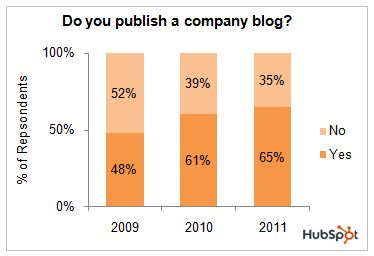Businesses that blog is now a majority.
In their most recent study, Inbound Marketing software firm HubSpot found that businesses that blog grew 17% from 2009 to 2011. In two years the number of businesses with an active blog grew from 48% to 65%. That’s a big increase and it finally means businesses with blogs are in the majority.
This is third consecutive year in which the study was conducted. The 2011 research was based on responses from over 600 professionals knowledgeable about their business’ marketing practices.
This rapid growth means that businesses are now in the minority if they do not blog.
These stats and charts are good to show the increase in popularity of blogging, but what does it mean for your company?
Company Blogging in 2011
Stats are nice for comparison and charts are good visuals, but the important question business owners should ask themselves is “Should my company have a blog?”.
Getting into blogging can be an important step for businesses. However, it takes the correct strategy and enough resources to ensure a company blog is successful at driving sales either directly or indirectly. Without the proper understanding of how a blog will drive sales for your business there may be no reason to start.
Blogging Strategy
A good place to start when determining if a blog is right for your company is to understand that business to business companies will generally see more direct revenue as a result of their blogging efforts. Perhaps the medium better presents itself to converting readers to clients in the B2B world. Kevin Hillstrom sees 70% of his consulting revenue come via his blog compared to his e-commerce clients that don’t see as much direct revenue from blogging efforts.
If you’re a business with business clients it seems a blogging strategy is more urgent. Start by looking at your competitors. Some may have blogs started. Brainstorm the direction you want to take for the blog. Think about the voice you’ll want the blog to have. Most businesses will succeed by developing a voice of leadership in their industry. Interpreting news in the industry and providing unique insight into the key factors affecting your industry is a great place to start for a B2B blog.
Most blogs suffer from a lack of post frequency and consistent scheduling. It’s difficult, especially in the first six months to a year, to maintain a consistent posting schedule. Readers appreciate consistent posts. Determine who will do the blogging for your company and make sure this person or persons are able to post consistently whether that’s once a week, once a month, twice a week, etc.
For business to consumer companies the focus on blogging needs to be different.
Business to consumer companies need to look at tracking how blogging can impact an overall branding campaign. A company blog can help drive the way your brand is perceived in the industry. Brands can take a leadership position in their industry just like B2B companies. For example, a strategy for an apparel retailer may be to share the latest trends in the fashion world. Focus on providing insight into the world your company and customers live in. Providing insight your customers can’t get anywhere else. In-house merchandisers are great assets for retail companies. Pick their brains for trend information and share it via a blog with your customers.
Another example could be a blog like The Apron Blog by Home Depot. The best posts here are tips on how to improve your home during spring cleaning or How-to posts on gardening.
Summary
A blog is a digital asset for your company.
The content you and your team creates lives on your domain forever. The insight you provide will drive customers to you as they search for answers to their questions. Blogging is a long term strategy that can improve your company’s standing with the proper execution.

